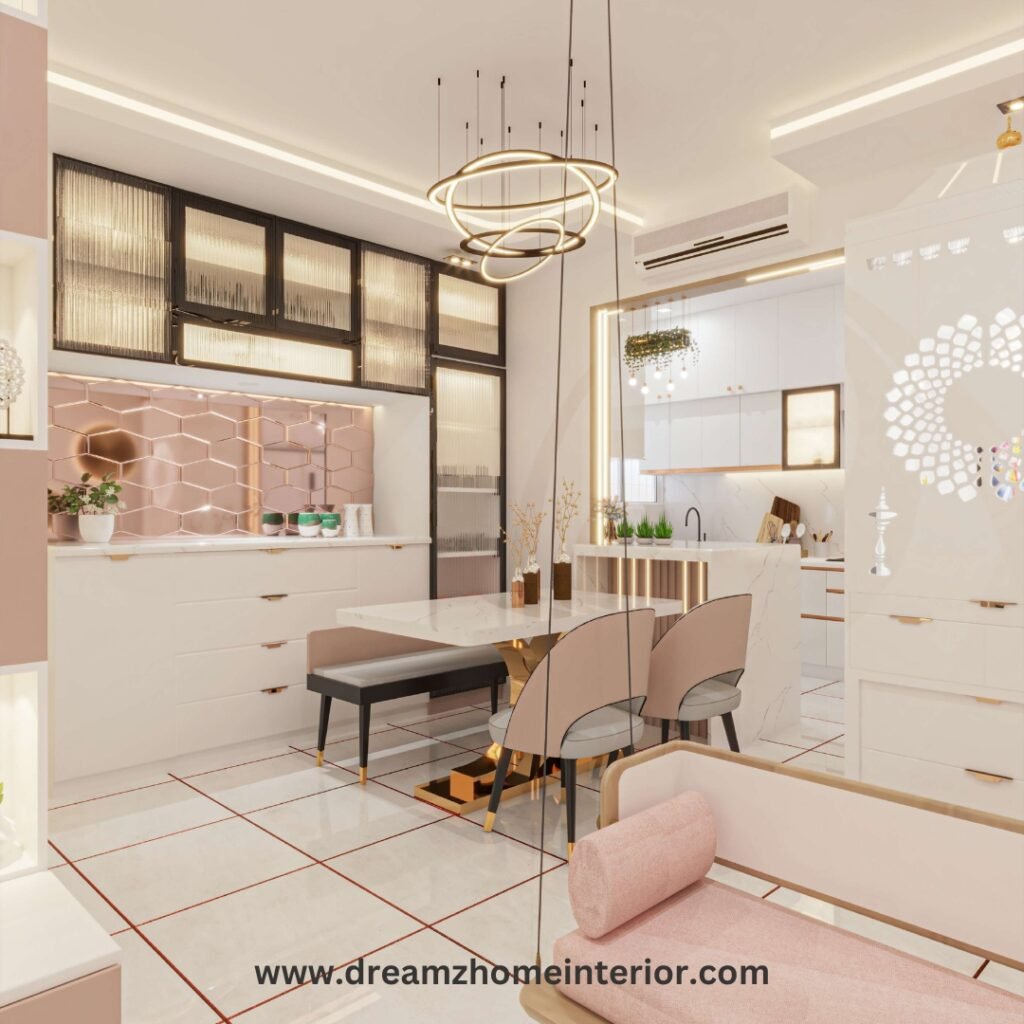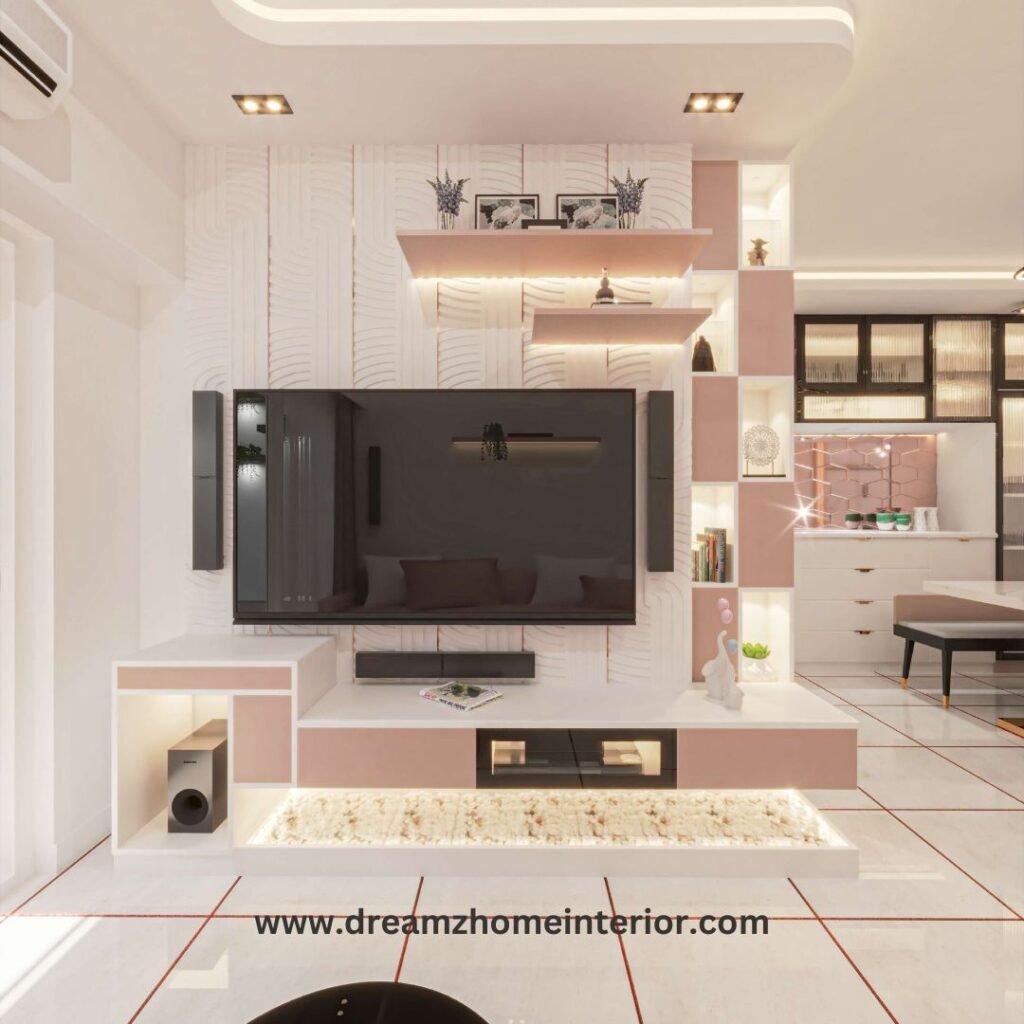A positive atmosphere in a home can transform the way you live, work, and interact with your surroundings. It influences your mood, productivity, and overall well-being. At Dreamz Home Interiors, we understand the profound impact that a well-designed space can have on your life. Whether you’re looking to refresh a single room or undertake a complete home makeover, our team of experts is here to help you create a harmonious and inviting environment. In this comprehensive guide, we’ll share seven transformative ideas to help you create a positive atmosphere in your home.
1. Embrace Natural Light and Airflow
The Power of Natural Light

Natural light has a remarkable ability to uplift your mood and create a sense of openness in any room. Large windows, skylights, and glass doors are excellent ways to maximize natural light. Consider the following tips to enhance the natural light in your home:
Use Light Colors: Light-colored walls and furniture reflect natural light, making spaces feel brighter and more spacious.
Mirrors: Strategically placed mirrors can amplify the effect of natural light by reflecting it throughout the room.
Sheer Curtains: Opt for sheer or light-colored curtains to allow light to filter through while maintaining privacy.
Enhancing Airflow
Good airflow is essential for a healthy and positive home environment. Proper ventilation helps to eliminate indoor pollutants and brings in fresh air. Here are some ways to improve airflow in your home:
Windows and Doors: Keep windows and doors open whenever possible to allow fresh air to circulate.
Ceiling Fans: Install ceiling fans to facilitate air movement and keep the atmosphere fresh.
Plants: Indoor plants not only improve air quality but also add a touch of nature to your space.
2. Harmonize with Colors
Understanding Color Psychology
Colors have a significant impact on our emotions and can influence our mental state. By understanding color psychology, you can choose hues that promote positivity and well-being. Here are some color suggestions for different areas of your home:
Living Room: Warm and neutral colors like beige, light brown, and soft gray create a welcoming and cozy atmosphere.
Bedroom: Cool and calming colors such as blue, lavender, and soft green promote relaxation and restful sleep.

Kitchen: Vibrant colors like yellow, orange, and red stimulate appetite and create an energetic environment.
Home Office: Light blue, green, and soft gray enhance focus and productivity.
Creating Color Harmony
To create a cohesive and harmonious look, consider the following tips:
Color Palette: Choose a color palette that complements your overall design theme and stick to it throughout your home.
Accent Colors: Use accent colors to add interest and depth to your space. These can be incorporated through accessories, artwork, and textiles.
Balance: Ensure a balance between warm and cool tones to create a visually appealing and comfortable environment.
3. Incorporate Natural Elements
The Benefits of Biophilic Design
Biophilic design integrates natural elements into your home to create a connection with nature. This approach has been shown to reduce stress, improve mood, and enhance overall well-being. Here are some ways to incorporate natural elements into your home:
Indoor Plants: Choose a variety of indoor plants to add greenery and improve air quality. Consider low-maintenance options like succulents, snake plants, and pothos.
Natural Materials: Use natural materials such as wood, stone, and bamboo in your furniture and decor to create a warm and organic feel.

Water Features: Incorporate water features like indoor fountains or aquariums to add a soothing and calming element to your space.
Bringing the Outdoors In
To create a seamless connection between indoor and outdoor spaces, consider the following tips:
Large Windows: Install large windows that offer views of your garden or outdoor scenery.
Indoor-Outdoor Living: Create indoor-outdoor living spaces with sliding doors or retractable walls that open up to your patio or garden.
Natural Light: Maximize natural light to enhance the feeling of being connected to the outdoors.
4. Declutter and Organize
The Impact of Clutter on Mental Health
Clutter can create a sense of chaos and negatively impact your mental well-being. By decluttering and organizing your space, you can create a more positive and stress-free environment. Here are some steps to help you declutter and organize:
Assess and Purge: Go through each room and assess what you truly need and use. Donate or discard items that no longer serve a purpose.
Storage Solutions: Invest in storage solutions such as shelves, cabinets, and baskets to keep your belongings organized and out of sight.
Create Zones: Designate specific areas for different activities to maintain order and functionality in your home.
Maintaining an Organized Space
Once you’ve decluttered and organized, it’s important to maintain the order. Here are some tips to keep your space tidy:
Daily Tidying: Spend a few minutes each day tidying up to prevent clutter from accumulating.
Storage Systems: Use storage systems like labeled bins and drawer dividers to keep items in their designated places.
Minimalism: Embrace a minimalist mindset by only keeping items that bring you joy and have a purpose.
5. Personalize Your Space
Expressing Your Personality
Your home should be a reflection of your personality and style. Personalizing your space not only makes it unique but also creates a sense of comfort and belonging. Here are some ideas to personalize your home:
Artwork and Photos: Display artwork and photos that resonate with you and tell your story.
Customized Decor: Incorporate customized decor items like monogrammed pillows, personalized signs, and bespoke furniture.
Collections and Hobbies: Showcase your collections and hobbies to add a personal touch and spark joy.
Creating a Sense of Identity
To create a cohesive and personalized space, consider the following tips:
Consistent Theme: Choose a consistent theme or style that reflects your personality and preferences.
Mix and Match: Don’t be afraid to mix and match different styles, colors, and textures to create a unique and eclectic look.

Meaningful Items: Surround yourself with items that hold sentimental value and evoke positive memories.
6. Focus on Comfort and Functionality
Prioritizing Comfort
Comfort is key to creating a positive atmosphere in your home. Invest in furniture and decor that not only looks good but also feels good. Here are some ways to prioritize comfort:
Quality Furniture: Choose high-quality furniture that offers both comfort and durability. Consider ergonomic designs for seating and workspaces.
Soft Textiles: Incorporate soft textiles like plush rugs, cozy blankets, and comfortable cushions to create a warm and inviting atmosphere.
Lighting: Use a combination of ambient, task, and accent lighting to create a well-lit and comfortable environment.
Enhancing Functionality
Functionality is equally important in creating a positive home atmosphere. A well-designed space should be practical and easy to navigate. Here are some tips to enhance functionality:
Layout: Arrange furniture and decor in a way that promotes easy movement and flow.
Multi-functional Spaces: Design multi-functional spaces that can serve different purposes, such as a home office that doubles as a guest room.
Smart Storage: Use smart storage solutions to keep your space organized and clutter-free.
7. Create Relaxation Zones
The Importance of Relaxation
In today’s fast-paced world, having a dedicated space for relaxation is essential for maintaining mental and physical well-being. Creating relaxation zones in your home can help you unwind and recharge. Here are some ideas for creating relaxation zones:
Reading Nook: Set up a cozy reading nook with a comfortable chair, good lighting, and a selection of your favorite books.
Meditation Corner: Create a serene meditation corner with soft cushions, calming scents, and soothing music.
Spa-like Bathroom: Transform your bathroom into a spa-like retreat with luxurious towels, scented candles, and soothing bath products.
Designing for Tranquility
To design relaxation zones that promote tranquility, consider the following tips:
Calming Colors: Use calming colors like soft blues, greens, and neutrals to create a peaceful atmosphere.
Natural Elements: Incorporate natural elements like plants, water features, and natural materials to enhance the sense of tranquility.
Minimalist Decor: Keep decor simple and clutter-free to create a serene and uncluttered space.
Read Also : Transform Your Culinary Haven: The Importance of Stunning Kitchen Interiors by Dreamz Home Interiors
Conclusion
Creating a positive atmosphere in your home is a transformative journey that can significantly enhance your quality of life. By embracing natural light and airflow, harmonizing with colors, incorporating natural elements, decluttering and organizing, personalizing your space, focusing on comfort and functionality, and creating relaxation zones, you can create a harmonious and inviting environment. At Dreamz Home Interiors, we are dedicated to helping you achieve your vision and transform your home into a sanctuary of positivity and well-being. Contact us today to start your journey towards a more positive and beautiful home.

